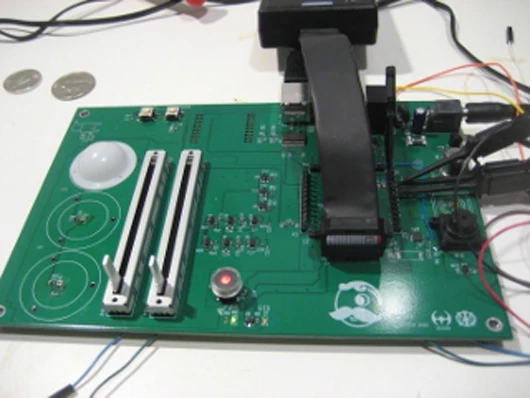According to a 2009 Department of Energy study, lighting accounts for 22 percent of all the electricity used in the United States. In an effort to cut this figure, many modern buildings have done away with the humble light switch in favor of automatic motion-detector switches or complicated control panels with arrays of sliders and buttons. A new system literally puts the controls back in people’s hands and its developers at MIT say it has the potential to slash lighting bills by more than half.
The experimental system consists of control devices about the size of a business card that can be placed on users’ desktops. They contain light sensors to monitor the light falling on the user’s workspace, as well as controls to adjust both the intensity and the color balance of the light. In the current test setup, the devices are used to control of LED light fixtures, which are energy efficient and can also be easily adjusted to any level of intensity.

Not only do the controllers measure the intensity of light falling on the workspace, but they can also identify how much light comes from different fixtures, while also separately measuring any ambient light coming in the windows or spilling over from neighboring work areas. This allows the overhead lights to automatically dim or switch off altogether if the sunlight from the window is sufficient to light the workspace. Then, if clouds roll in and the sunlight decreases, the lights are immediately reactivated.
The color balance of the light can also be adjusted by varying the intensity of individual LED lamps of different colors in the overhead fixtures.
Energy savings of up to 90 percent
In tests of the system so far the researchers found that it reduced the energy used for lighting by 65 to 90 percent – and that’s on top of the savings resulting from using LEDs over incandescent lights or compact fluorescents. And as well as saving energy, the system is potentially more comfortable for the user. As research associate Matthew Aldrich explains: “It opens up the space for user controls, so you can adapt the lighting to what suits you best.”

Currently, whenever the sensor is moved, the system needs to ramp the lighting up and down so it can be recalibrated. This produces a brief but distracting short sequence of light and dark, which Aldrich is hoping to overcome by incorporating infrared (IR) LEDs in the light fixtures and IR sensors in the controllers in the future. This would allow the calibration and adjustment of light levels to be done invisibly and without unnecessary distractions. The researchers are also using cameras to measure reflected light across illuminated areas and studying ways of using gestures for lighting control.
The MIT team is also studying user reactions to ascertain whether it would be more effective to let each user control their own workspace, or to allow a single control for an area or work group and whether it is better to have the controls in fixed locations, or have portable devices that control lights as a user moves around a building.
“We want to see how users will interact with it, to see if we can really realize these energy savings,” Aldrich says.
Preliminary results of the ongoing research, which is funded by the Media Lab, were published earlier this year in the Proceedings of SPIE, in a paper co-authored by Aldrich, Media Lab Associate Professor Joseph Paradiso and visiting student Nan Zhao.







